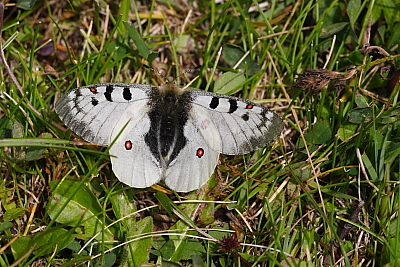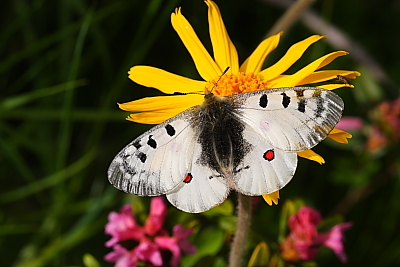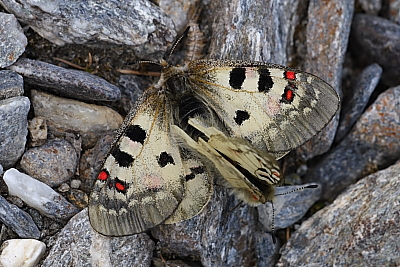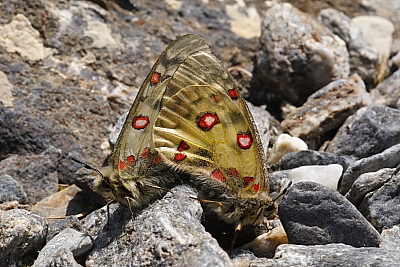

27219_male_Hautes-Alpes_14Jul11
27175_female_Hautes-Alpes_14Jul11






27186_female_Hautes-Alpes_14Jul11
Small Apollo (Parnassius phoebus)
2024 photographs highlighted in yellow. Click on any photograph to go to an enlarged picture, or simply scroll down the page.
|
Very similar to its close cousin, the Apollo (P. apollo), although much less frequently encountered. It tends to be found at higher altitudes and Lafranchis gives the normal minimum altitude as 1800m, although occasionally occurring as low as 1300m.
The female is slightly larger and with a greyish suffusion and heavier markings generally, usually with a upf black spot in the discal region of s1b (where the male either does not - see 31123 - or occasionally - see 27219 - a very small mark). Phoebus has two subspecies in France, sacerdos, the normal subspecies (as on this page), and gazeli, a very white subspecies occurring in a few high altitude locations in the Alpes-Maritimes.
Phoebus is a species that always seems to stay close to water, often being seen at the edges of rivers, even if flowing torrentially. |
Phoebus can be distinguished from apollo by the absence of the black spot in s1b of the upf, only true for (most) males, although the females could be differentiated by the much more extensive greyish suffusion of phoebus. The phoebus upf post-discal spot in s8 is red-centred, whereas for apollo it is not; this holds true for both sexes. The definitive difference is that the phoebus antennal shaft is clearly ringed whereas the apollo shaft is indistinctly ringed. The male phoebus has a distinctly creamy-white appearance. Apollo also flies at subalpine levels.
The females of (I believe) all three French Parnassius species have a device at the end of the abdomen to prevent mating when it has already done so, called a sphragis. I believe it to be a waxy substance applied by males after copulation which then hardens. The Clouded Apollo (P. mnemosyne) female sphragis is particularly large and can clearly be seen on examples on the mnemosyne page. I have not seen or read of the phoebus sphragis anywhere, but I understand it is a feature of Parnassius species. |
|
ref |
sex |
observations |
alt. m |
| 31123 | M | a typical male. | 2090 |
| 31188 | M | a male, the red marks in upf s8 are very small almost to the point of being vestigial. | 2090 |
|
27219 |
M |
a male, lightly marked and settling, as it often seems to do, low in grassy regions. |
2550 |
|
27175 |
F |
a female, the characteristic duskiness being quite apparent. 27186 is the underside. |
2040 |
| 38106 | M | a male, seen at a riverside location close to the Italian border. | 1900 |
| 38145 | PAIR, M | a mating pair, the male being visible in this shot, the female being largely obscured below. This, and the next three images, are of the same pair. In 38122 this pair were being attacked by another male who considered himself invited to the party. The male shown has some brownish liquid on the wings, which may have been secreted there by the other male which had departed at the time of this shot. | 2020 |
| 38139 | PAIR, F | the female of the mating pair, following the attack by the uninvited male. The male involved in the mating is below with closed wings. This is a particularly dusky female, rather more so than others I have seen. | 2020 |
| 38122 | PAIR | it might take some working out what is going on here, but the yellow female on the left is in copula with the male that is almost end-on. The male side-on is trying, very forcibly, to join the party, I suspect by trying to split the two that are joined. It is not an uncommon sight to see a mating pair being vigorously attended by another male, sometimes even two males, but the degree of ferocity that was going on here was something I had never witnessed before. The numbering of the shots shows the order of the action here. The female underside was particularly yellow. | 2020 |
| 38158 | PAIR | the same pair, after the aggression had finished. The yellower female is on the right. | 2020 |
|
27186 |
F |
a female, the underside of 27175. The three red rings are more suffused in phoebus than apollo, where the red rings are quite crisp with clear white centres. |
2040 |
| 38194 | HOSTPLANT | the larval hostplant, Saxifraga aizoides (Yellow Mountain Saxifrage). | 2020 |
31123_male_Valais, Switzerland_12Jul12
31188_male_Valais, Switzerland_12Jul12
27219_male_Hautes-Alpes_14Jul11
27175_female_Hautes-Alpes_14Jul11
38106_male_Alpes-Maritimes_4Jul15
38145_pair, male_Hautes-Alpes_6Jul15
38139_pair, female_Hautes-Alpes_6Jul15
38122_pair_Hautes-Alpes_6Jul15
38158_pair_Hautes-Alpes_6Jul15
27186_female_Hautes-Alpes_14Jul11
38194_larval hostplant_Hautes-Alpes_6Jul15